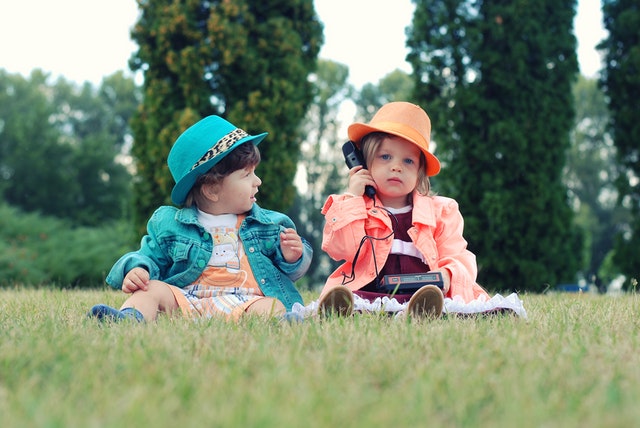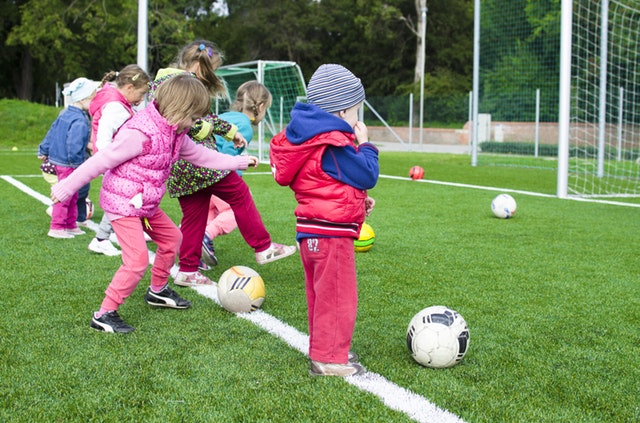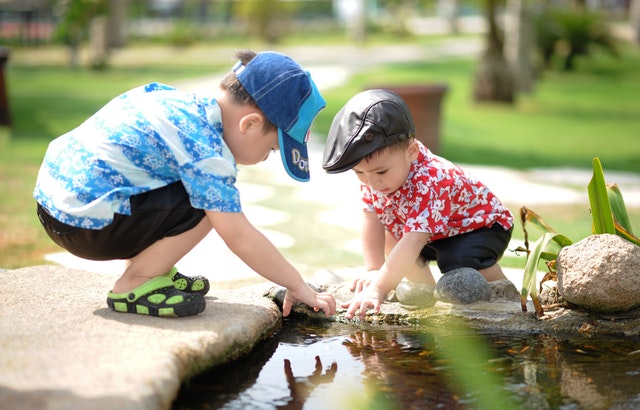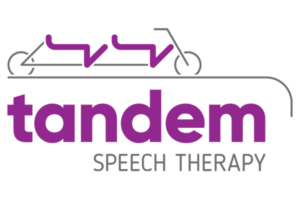This week I am excited to welcome Brooke Andrews, MA, CCC-SLP as a guest blogger for Tandem Speech Therapy. She is the owner of The Speech Dynamic in Houston, TX. Brooke specializes in social communication, language delays and differences, and play-based learning.
This post is the second part of a blog post Brooke shared on her website. Read the first part, “Play, Language, and Learning–How the ‘Magic’ Happens” on The Speech Dynamic.
The Power of the Play: The Foundation for Social and Emotional Intelligence and a Happy and Healthy Life
Play is more than recreation for children. Play is how children learn about the world. It’s how they learn to problem-solve, use language, build executive functioning skills, form relationships, and learn to take the perspectives of others. Play develops the social skills people use to relate with, play with, learn from, and teach others. It teaches us how to express emotions, delay gratification, and understand and appreciate how others feel (Schiller, 2018). In other words, it builds social and emotional intelligence.
Children who have high social and emotional intelligence exhibit self-confidence, express natural curiosity, make thoughtful choices, relate to others, know others’ feelings and express concerns, communicate needs, desires, and ideas, solve problems through compromises and negotiations and employ calming strategies (Schiller, 2012).
Social skills and emotional intelligence are important for meaningful relationships and a good life (Schiller, 2018). Additionally, social and emotional intelligence are correlated with success in life. In fact, high social and emotional intelligence is correlated with SAT scores an average of 210 points higher! In the famous “marshmallow experiment,” the children who waited the longest to eat their marshmallow were more popular, had higher SAT scores, higher GPAs, and were better able to handle stress ten years later! (Mischel & Shoda, 1988). Ultimately, the children who were able to delay gratification in favor of reaching a long-term goal were more successful later in life. During play, children must also learn to delay gratification. They learn to wait their turn and share with others. This requires cognitive control and refers to maintaining impulse control, managing upsetting emotions well, holding focus, and possessing a readiness to learn (Daniel Goleman). This skill is a better predictor of success than academic skills. This type of intelligence must be cultivated through experiences. In early childhood, these experiences are primarily through play.
During play, children “try on” various roles and relationships (ex: “I’m the mom, and you’re the baby”). This builds perspective-taking skills and theory of mind, the knowing that others have different thoughts, beliefs, and intentions than you do. During play, children learn self-regulation and self-control. Acting on impulses such as hitting or having a tantrum may end the game or result in other children not wanting to play. Play also encourages “if-then” thinking called conditional reasoning (Wesiberg & Gopnik, 2013). “If I’m the doctor, then I get to wear the coat” is the same skill children use to think about the future- “If I hit my friend, he would feel sad, and I would get in trouble.” This inhibition is one of the foundational areas of executive functioning. Children also build cognitive flexibility as they change their plans and flexibility change roles and props. Children engage their working memories as they coordinate and add to the play. According to the Harvard Center for the Developing Child, these three areas- inhibition, cognitive flexibly, and working memory are the core executive functions.
Infants learn to communicate via gestures and vocalizations. Through interactions with a responsive caregiver, infants develop attachment and emotional bonds. These interactions develop into back and forth communication (social reciprocity) and lay the foundation for communication and social skills. Parents are their child’s first play partners. Through playful interactions and early games such as Pee-a-Boo, parents teach their babies about social communication and language. Between nine and twelve months, babies begin to communicate with intention and begin using a point to direct their caregiver’s attention. As they learn to use language, children are able to communicate their wants and needs, share their interests and ideas, and use language to connect with others.
An incredible amount of brain development is happening during the early years. In fact, 80% of the brain is wired by age three and ninety percent is wired by age 5 (Schiller, 2018) The brain wires with experiences and neural pathways strengthen with repetition. By giving children plenty of language input throughout the day and many opportunities for play, we provide the developing brain with opportunities for learning. When we value play in early childhood, we build a strong foundation for communication, language, cognitive skills, problem-solving, and social skills.
Just like any other area of development, there is a developmental progression of play skills. It’s important to keep in mind that play and language go together. Play and language both use symbolic substitutions (words/letters for language and objects for play). During play, children have ample opportunities to develop and refine language, social skills, emotional intelligence, and cognitive skills. Recognizing which stage of play can your child is in can help you be intentional about encouraging their play skills. In other words, it allows you to play with purpose. Stages of play are summarized below:
Onlooker Play: Under two years. Children play passively while watching other children engaged in play.

Goals for Onlooker Play: Our goal at this stage is to encourage children to share space. Set up space so that children can play near each other. You can also provide your child with opportunities to watch other children play. Trips to the park are great for this! Modeling of higher levels of play is one of the great things about mixed-aged play!
Goals for parallel play: Just as children are understanding new relationships in their language skills, toddlers at this age are exploring new relationships between objects in play. As children start to understand that objects can be symbols, they start to understand one object can stand for another. For example, a block can be a bone for the dog as well as a pillow for his bed. By encouraging objects that are more open-ended (blocks, Play-Doh, etc.), you are encouraging your child to think to develop symbol substitutions. You can help by modeling symbolic substitutions (“Here’s my steering wheel!”) while holding a paper plate. Children reach higher levels of play with adult support.
Parallel Play: Two years old. Children play near other children while engaged in their own play activity.

Associative Play: 3-4 years. Children share materials but are not yet coordinating play.

Goals for associative play: The goal here is to get children to assign roles, create a plan, and “share an imagination” (Winner, 2014). By encouraging children to think ahead about their play plan, you can encourage them to start to coordinate their play: “Which one of you is going to be the doctor?” “Why are you going to visit the doctor today?” This is something children at higher levels of play do naturally. By pre-planning the play, you can help get children on the same page, mitigate potential conflicts, and get them thinking about their play in a more advanced way. (Bodrova & Leong-Tools of the Mind).
Goals for cooperative play: Cooperative play extends over time and explores relationships between people. Providing plenty of background knowledge through books, visits, and outings in the community give children more “material” to explore during play. By 4-5 years old, children begin to show more advanced theory of mind, meaning they understand that other people have different thoughts and feelings than they do. This is important for taking the perspectives of others and making choices based on how they want others to feel. We can support social intelligence by coaching children through problem-solving and conflicts during play. Using the five essential steps of Emotional Coaching from John Gottman (www.Gottman.com), parents can “coach” their children through their emotions. The steps are as follows: 1) Become aware of your child’s emotions 2) Recognize your child’s expression of emotion (connect with them) 3) Listen with empathy and validate your child’s feelings 4) Help your child label their emotions with words 5) Help them to solve the problem and find a solution.
Cooperative Play: 4-6 years. Children organize themselves into roles and coordinate specific goals for the play.


Are you looking for more more ways to make your play powerful?
Brovoda, E., Leong, D. Tools of the Mind: The Vygotskian Approach to Early Childhood Education
Goleman, D (1998) Emotional Intelligence. New York: Bantman
Mischel, W., Y, Shoda., and P.K. Peake. Follow-up to the Marshmallow Test “The Nature of Adolescent Competencies Predicted by Preschool Delay of Gratification. Journal of Personality and Social Psychology 54(1988): 687-96
Schiller, P. B. (2012) Start Smart Building Brain Power in the Early Years. Lewisville, NC: Gryphon House.
Schiller, P. B (2018, January). Right from Birth: Social and Emotional Intelligence. Presentation from the R. T. Garcia Early Childhood Conference, Houston, TX.
Weisberg, D.S.. & Gopnik, A. (2013). Pretense, Counterfactuals, and Bayesian Causal Models: Why What is Not Real Really Matters. Cognitive Science, 37, 1, 368-138.
Westby, C., Calutta, B. Language, Speech, and Hearing Services in Schools, October 2016, Vol. 47, 260-282. doi:10.1044/2016_LSHSS-15-0073
Westby, C. Theory of Mind Interventions to Develop Social-Emotional Skills. Pesi Rehab.
Start Playing With Purpose
Learn how to purposefully and intentionally interact with your child during play and help them increase opportunities for speech and language development with our Playing with Purpose book!












